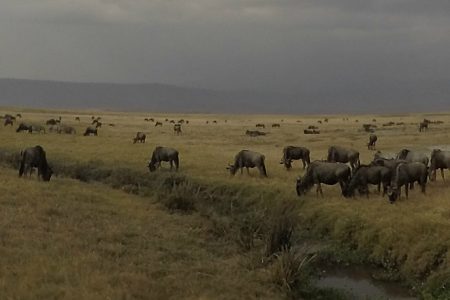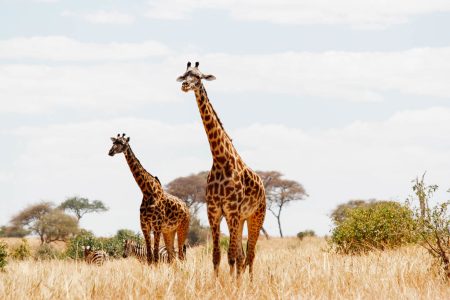Experience Ndutu calving season (only from October to 31st January)
The calving season is a prominent feature of the great wildebeest migration occurring in Tanzania. The calving season in Tanzania occurs between January, February, and March. The calving season occurs in the southern grasslands of Serengeti National Park and the Ndutu region.
The remarkable wildebeest migration ranks among the world’s natural wonders, with over 8,000 wildebeests born daily in the grasslands, observable on the southern plains of Serengeti National Park and the Ndutu region during safaris.
The wildebeests migrate in a circular orientation, pursuing rainfall to locate verdant grazing areas in the southern region of Serengeti National Park. During the migration, zebras and gazelles are observed grazing alongside the wildebeests. The rains facilitate the wildebeests’ access to fresh pasture in the Ndutu region.
Numerous predators, like as lions, cheetahs, and leopards, are observable during the wildebeest migration across the southern grasslands of Serengeti National Park. These predators can be observed during safaris near wildebeest herds as they pursue the calves. The wildebeest calving in Tanzania occurs in the short grass plains, facilitating the detection of predators during safari excursions in the Serengeti National Park and the Ndutu region.
Numerous campgrounds are established in proximity to the wildebeest calving regions in Ndutu Tanzania, enhancing the wildlife viewing experience by positioning visitors in optimal locations to observe the wildebeest migration.
Tanzania safaris, particularly during the calving season in the Ndutu region and other locations, are exhilarating experiences. These can be conducted as group or private safaris, allowing travelers to observe the birth of calves and their subsequent frolicking on the savannah right after delivery.
Wildlife observation in Tanzania is feasible year-round, with the optimal period for safaris being during the dry season from June to October, when various species are readily visible on the savannah plains and around water sources where they congregate to drink.
Recommended safaris Packages

3 days Wildebeest Migration Safari in Ndutu region
3 days Wildebeest Migration Safari in Ndutu region is designed for travelers seeking to witness the calving season of the great wildebeest migration in the Serengeti. The great wildebeest migration is a cyclical movement that traverses Serengeti National Park and proceeds to Masai Mara via the Mara River, culminating in the renowned Mara River crossing,

16 Days best of Tanzania Safari in the Northern Circuit.
16 Days best of Tanzania Safari in the Northern Circuit, Have you got plenty of time on your hands anyway, decision-making isn’t your thing or has it not been easy? Then you should definitely choose this itinerary, since it expertly incorporates all the elements that a Tanzanian safari visitor may desire. If you are interested in visiting Tanzania’s northern parks,

11 Days safari trip to tanzania zanzibar
Join us for an 11-day Tanzania Safari & Zanzibar vacation to witness the hypnotic beauty of Tanzania. Enjoy your stay in Tanzania to the fullest. Embark on an African safari and see exotic animals up close, or relax on Zanzibar’s lush beaches. Get to know Tanzania at your leisure on this private, luxurious safari. With the help of your knowledgeable English-speaking

7 Days Serengeti Hot Air Balloon and Gorillas
7 Days Serengeti Hot Air Balloon and Gorillas, you will embark on a mind-blowing safari adventure to one of the most visited destinations in Tanzania, Serengeti National Park, best known for its amazing wildlife viewing adventures and awe-inspiring hot air balloon safaris. It will also take you across borders

4 Days Serengeti and Ngorongoro Crater Safari
The 4 Days Serengeti and Ngorongoro Crater safari is a highlight to Tanzania’s popular and unique national parks. The trip takes you in to Serengeti national park and Ngorongoro where you will be able to spot a variety of animals. Both Ngorongoro Crater and Serengeti are UNESCO world heritage sites

3 days Arusha, Ngorongoro and Lake Manyara wildlife safari
3 days Arusha, Ngorongoro and Lake Manyara wildlife safari will take you to the vicinity of Mount Meru, which stands at 4,565 meters, as well as the Ngurdoto Crater and Momella Lakes. The park offers the most exceptional vistas of Mount Kilimanjaro relative to any location in Tanzania.
The remainder of the wildebeest migration in Tanzania
In addition to the calving season occurring in the southern region of Serengeti National Park and the Ndutu area, the wildebeest migration yearly transpires inside the Mara-Serengeti ecosystem, where approximately 2 million wildebeests can be observed during safaris.
April and May
Following their foraging in the Ndutu region, the wildebeests proceed with their migration toward the middle section of Serengeti National Park. This occurs in April and May, coinciding with the rainy season. While on a safari in the central region of Serengeti National Park, various wildlife species can be observed, including elephants, lions, leopards, buffalo, hippos, giraffes, impalas, gazelles, zebras, kudu, and hartebeests, among others. The central region of Serengeti National Park, known as the Seronera Region, is inhabited by a multitude of wildlife species.
Safaris to Tanzania in April and May are discounted, resulting in decreased expenses. During the rainy or low season, tourist numbers on safari are limited, making it an opportune time to evade crowds at the destination.
June and July
The wildebeest migration progresses from the central region of Serengeti National Park to the western region around June. The migration is observable along the Grumeti River, which serves as a crossing site for the wildebeests.
In July, the wildebeest migration progresses toward the northern region of Serengeti National Park. The northern section of the national park features river crossings along the Mara River, a perilous location for wildebeests due to attacks from Nile crocodiles.
August, September, and October
After crossing the Mara River, the wildebeests go to the Masai Mara National Reserve in the southwestern region of Kenya.
Wildebeests are observable in the northern regions of Serengeti National Park throughout August, September, and October. Following the migration in Kenya, the wildebeests return to Serengeti National Park, initiating the migration anew.
November and December
During November and December, the wildebeest herds migrate to the southern plains of Serengeti National Park for the calving season, after which the migration recommences.
Various methods exist to reach Serengeti National Park for the calving season safaris, including a 7-hour drive from Arusha to the southern region of the park, and a 6-hour drive from Arusha to the Ndutu area. An alternative route to the Ndutu area is via aircraft to either Ndutu airstrip or Seronera airfield.